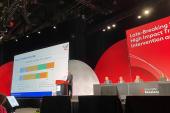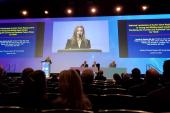AHA Weighs in on Risks of Noncardiac Surgery in Congenital HD Patients
Clinicians who treat these patients should understand the added complexities and when to ask for help, Viviane Nasr says.

As the population of pediatric patients with congenital heart disease (CHD) grows, a new scientific statement from the American Heart Association (AHA) highlights the current knowledge base surrounding the spectrum of care these patients might need before, during, and after noncardiac surgery.
While patients with CHD are often referred for procedures through their cardiologist, there are often “multiple providers from multiple specialties involved,” writing committee chair Viviane Nasr, MD, MPH (Boston Children’s Hospital, MA), told TCTMD. While there is not yet enough published evidence to support the publication of any kind of official guideline for these patients, Nasr said, “we figured a statement will help get some information to all kinds of providers when caring for those patients.”
The primary goal of the statement, published online this week in Circulation: Cardiovascular Quality and Outcomes, is to point out the mortality and morbidity risks these patients can face when undergoing noncardiac procedures, according to Nasr. Also, the authors wanted to enable physicians who do not have cardiac anesthesia training, but do take care of these patients, to do so safely and recognize when to call for help.
The paper shows that while the number of both inpatient and outpatient noncardiac encounters for patients with CHD has steadily risen in recent years—with gastrointestinal and otolaryngological procedures the most common—the mortality rate associated with them has fallen.
The primary factor that influences mortality and morbidity risk is patient age, with younger patients, especially those under 1 year, being most vulnerable. However, cardiac lesion type and patient anatomy also play a role, the authors say, with a higher risk category assigned to single-ventricle patients or those with single-ventricle physiology.
Nasr and colleagues urge those involved with the care of these patients to perform a thorough preoperative assessment to gauge the risks involved with anesthesia care as well as “any possible implications of the noncardiac procedure,” they write. Moreover, depending on whether a patient is classified as having a minor, major, or severe cardiac classification, they can be further deemed to have a low or high risk for surgery, according to the authors’ algorithm.
Those at low risk don’t necessarily need to be seen by an anesthesiologist specialized in pediatric cardiology, nor will they necessarily need an ICU bed, and potentially they can be treated with an outpatient approach, according to the statement. However, the authors say, high-risk patients need specialty multidisciplinary care by those trained in CHD and should be treated at a center with ICU bed availability with postoperative inpatient monitoring.
Some studies have addressed the ideal location for CHD patients to undergo noncardiac procedures, but the question of whether they should always be seen at specialty cardiac centers remains unclear, Nasr said, adding that she would like to see future research focus on this issue.
“With surgical and cath lab [care] now more regional and allocated to special centers, does that matter for noncardiac procedures or can they just go to the neighboring hospital when the child gets hurt or breaks an elbow swinging at the playground?” she asked. “That is one of the factors affecting this. If that does matter, then how do you optimize the outcome and how do you optimize where they are living based on that?”
Nasr also underlined the problem of whether there will be enough specialized clinicians to treat the growing population of CHD patients in the coming years. “If we start limiting the workforce and who is going to care for those patients from an anesthesia perspective, I think it would be very difficult to really be able to achieve that with the number of providers that are available compared to the number of CHD patients at the moment,” she said.
Yael L. Maxwell is Senior Medical Journalist for TCTMD and Section Editor of TCTMD's Fellows Forum. She served as the inaugural…
Read Full BioSources
Nasr VG, Markham LW, Clay M, et al. Perioperative considerations for pediatric patients with congenital heart disease presenting for noncardiac procedures: a scientific statement from the American Heart Association. Circ Cardiovasc Qual Outcomes. 2022;15:e000113.
Disclosures
- Nasr reports no relevant conflicts of interest.





Comments